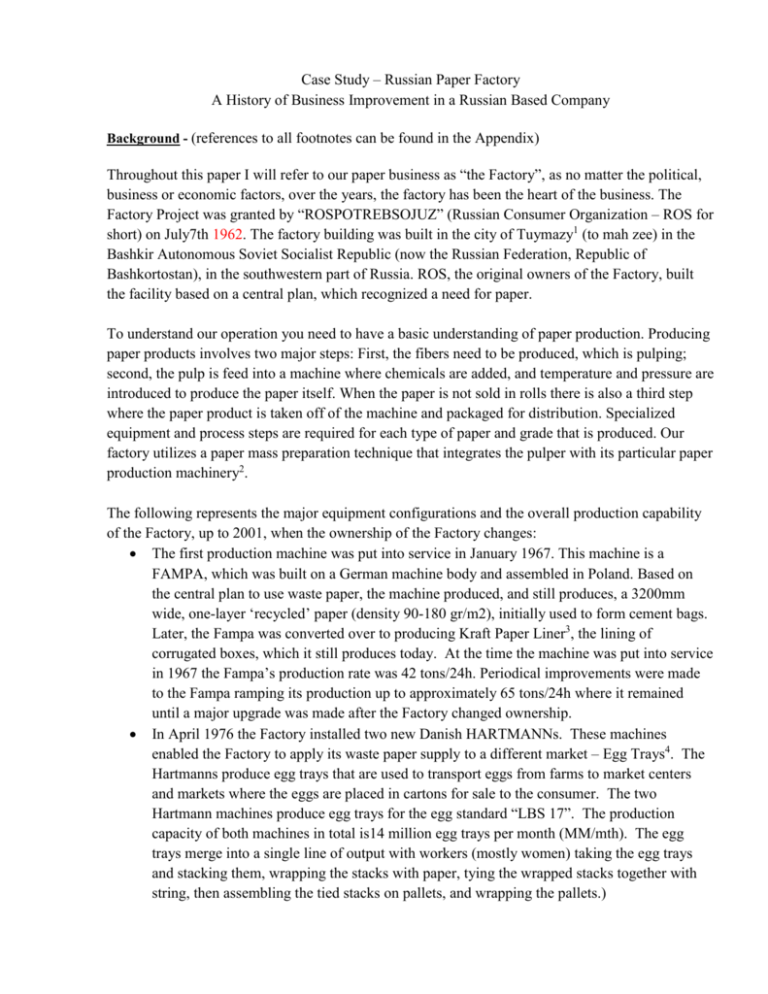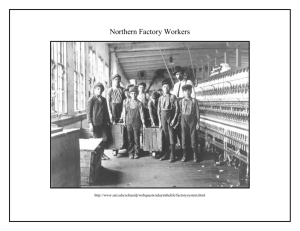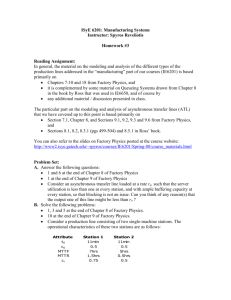Case Study – Russian Paper Factory A History of Business
advertisement

Case Study – Russian Paper Factory A History of Business Improvement in a Russian Based Company Background - (references to all footnotes can be found in the Appendix) Throughout this paper I will refer to our paper business as “the Factory”, as no matter the political, business or economic factors, over the years, the factory has been the heart of the business. The Factory Project was granted by “ROSPOTREBSOJUZ” (Russian Consumer Organization – ROS for short) on July7th 1962. The factory building was built in the city of Tuymazy1 (to mah zee) in the Bashkir Autonomous Soviet Socialist Republic (now the Russian Federation, Republic of Bashkortostan), in the southwestern part of Russia. ROS, the original owners of the Factory, built the facility based on a central plan, which recognized a need for paper. To understand our operation you need to have a basic understanding of paper production. Producing paper products involves two major steps: First, the fibers need to be produced, which is pulping; second, the pulp is feed into a machine where chemicals are added, and temperature and pressure are introduced to produce the paper itself. When the paper is not sold in rolls there is also a third step where the paper product is taken off of the machine and packaged for distribution. Specialized equipment and process steps are required for each type of paper and grade that is produced. Our factory utilizes a paper mass preparation technique that integrates the pulper with its particular paper production machinery2. The following represents the major equipment configurations and the overall production capability of the Factory, up to 2001, when the ownership of the Factory changes: The first production machine was put into service in January 1967. This machine is a FAMPA, which was built on a German machine body and assembled in Poland. Based on the central plan to use waste paper, the machine produced, and still produces, a 3200mm wide, one-layer ‘recycled’ paper (density 90-180 gr/m2), initially used to form cement bags. Later, the Fampa was converted over to producing Kraft Paper Liner3, the lining of corrugated boxes, which it still produces today. At the time the machine was put into service in 1967 the Fampa’s production rate was 42 tons/24h. Periodical improvements were made to the Fampa ramping its production up to approximately 65 tons/24h where it remained until a major upgrade was made after the Factory changed ownership. In April 1976 the Factory installed two new Danish HARTMANNs. These machines enabled the Factory to apply its waste paper supply to a different market – Egg Trays4. The Hartmanns produce egg trays that are used to transport eggs from farms to market centers and markets where the eggs are placed in cartons for sale to the consumer. The two Hartmann machines produce egg trays for the egg standard “LBS 17”. The production capacity of both machines in total is14 million egg trays per month (MM/mth). The egg trays merge into a single line of output with workers (mostly women) taking the egg trays and stacking them, wrapping the stacks with paper, tying the wrapped stacks together with string, then assembling the tied stacks on pallets, and wrapping the pallets.) Space considerations required that a new machinery building be built for the two new Hartmann machines. The new storage area, which was not, and is not, climate controlled, was also used to facilitate certain waste paper storage, and egg trays as finished goods. In the 1980’s new technology was introduced (fiber was separated in paper mass preparation, removing water content), which enabled wood fiber trays/pallets of waste paper to be produced for use in bread factories. Peak production was reached in 1992. After 1992 demand dramatically dropped. The Factory continued to build product to plan even though sales had dropped precipitously. The warehouse filled. The Factory began preparations to close and disband. Finally, in 2001 pallet production stopped. To fully understand how the Factory could continue to make pallets when there was no demand, and to appreciate the factors that had to be negotiated as the business matured, you must have some grounding in the recent history of the Russian Federation. Russia, as it is referred to in the U.S., was founded in 1991 with the dissolution of the Soviet Union. As a primer, here are some current basic facts: Russia is a federation of 83 federal subjects; in terms of land area, Russia is the largest country in the world spanning 11 time zones; Russia is the ninth largest country in population, 142 million; Russia has the eighth largest nominal GDP, and the sixth largest GDP when measured by purchasing power parity (PPP). The following provides a condensed post World War II history of the Russian Federation annotated to reflect the effects on the Factory: Timeline To 1991 Russian History Russia is the economic and political center of the Soviet Union 1991 Soviet Union disintegrates (but the system still operates the same until 1993); Yeltsin appointed, later elected President of Russia Economic depression 1992-1993 1993-1995* 1996-2000* *1994-2000 2000-Current Years of transition to privatization Devaluation of Currency (govt defaults on bonds). In 1998: Russian Stock Market crashes; ruble goes through 6 “revaluations” becoming essentially worthless; economy collapses * Massive corruption sets in. By 1994 Criminal Element comes into control of Unions. Factories are purposely run into the ground to lower the values of factories thereby allowing members of the “criminal element” to purchase selected individual factories from the Unions at a discount. Businesses that do not have high economic value, like paper, are neglected. 2000 Putin elected President - moves to (re)centralize power in Moscow, to limit power of wealthy business leaders, and to control, if not reduce, corruption 2001 Effect on Factory 1962 Factory is built, ownership by Consumer Union, Central planning from Moscow Factory remains under same ownership production continues to be directed by plan, but there is no sales plan and the market has substantially contracted money is skimmed off - running the factory, material supply, and sales are secondary considerations Ownership of the Factory changes As noted above, in 2001 the factory changes ownership. In the U.S. you would have said, the Factory had become “privatized”. This change of ownership, or “privatization”, comes with strict regulations and obligations imposed by the local government and community. Student Case Competition Page 2 of 5 APICS-Chicago 2009 The new owners are a Russian private equity firm, Voren Development. Voren’s plan for the business is straightforward, and similar to those plans that U.S. private equity firms employ: Improve and grow the business to that point that it can profitably be taken public. As would be expected, the Factory’s new management performed a full financial and operational review, noting internal flaws and detailing gaps in connections. This review lead to a fundamental reorganization. The Marketing, Finance, Technology, and Sales departments were reassembled. The Main Office Management, Finance and the Sales Department move to Saint-Petersburg approximately 2,000km away. An external Marketing firm was given the task of analyzing the Market. On the heels of the reorganization, the new management started a basic modernization of the equipment. This modernization effort included the following: • Two small additional egg tray machines were purchased and installed adding approximately 4MM/mth of total egg tray production capacity. More important than the increased production capacity, along with the new egg tray machines came new press forms enabling the Factory to serve demand for “LBS 20” and “LBS 25” egg trays. Also, and the additional machines had/have the ability to also produce egg cartons, which allowed the Factory to the opportunity to “test” egg carton production and the egg carton market. • In conjunction with expanding and increasing egg tray production, the production flow for egg trays was optimized, which eliminated unreasonable delays. • A new computer based control system was introduced to the company. “ECOSOFT” is like Oracle or SAP - not so cool but 1/10 the price. • Focus is given to kraft liner paper. In 2005 the Fampa paper machine experiences a basic modernization of every step of production from the pulper to a new storehouse concept. The modernization of the Fampa included: Main body reconstruction, service of rolls; Paper mass processing; Improvements to the Steam-Condensation System, A major upgrade of the drive, new component machines for coarse-fine cleaning of paper mass. In total, these efforts lead to an increase in output to 100tons/24h. (Picture of waste paper5 that will be used by the Fampa) It was during the major renovation to the Fampa that I had the first opportunity to have major responsibility for a project. The Factory’s outside Marketing firm had identified a new market area, and I was to jointly source, design and approve the large machine assembly that would produce the new product line. My responsibilities were to establish the basic machine configuration, to oversee the development of specific elements of the detailed equipment specifications, and to join in the development of the approval criteria. These project responsibilities meant that I had to oversee a segment of the development of an exhaustive multi-faceted engineering plan. However, before such plans can be developed several basic configuration decisions must be made. Establishing the machine configuration, which initially seemed to be a series of rather straightforward decisions, caused me to examine issues that neither I nor the Factory had ever fully contemplated. Student Case Competition Page 3 of 5 APICS-Chicago 2009 Even the most basic decisions can become complex as you add in and calculate all of the variables and possibilities. One of the configuration considerations was whether to install automatic machinery for packaging or utilize manual labor. To appreciate the manual versus automated calculation you need to know two things: First, the management wanted to upgrade capabilities, but was still very sensitive to capital expense; second, and most important, the Factory has traditionally profited from a location that has allowed it to draw upon a low cost work force. So, to prove the business case I calculated, from a purely economic point of view, two five-year cost plans for the operation of the new machine, one using manual pack out, and one using automatic packaging. I was surprised to find that a very capital cost intensive packaging machine would be significantly more economically efficient than the use of low cost labor. The potential cost savings offered through this single analysis for the new production line caused me to extend the calculation to every aspect of production and to each production line in the factory. The results of the extended calculations showed that the Factory was out-of-date in the way it was operating, and that the out-of-date operations had to be changed. When considered in total, it turned out that the low cost of labor had bred the misuse of labor over time. As labor was relatively inexpensive, all of the existing production used highly manual methods. Capital expenditure had not been made on a regular basis to replace old machines with newer more automated equipment. This practice of continuing to use older equipment caused a good part of the workforce to be employed in manual production jobs, which supported the older machines. By considering the cumulative number of inexpensive people that could be displaced by each automatic machine, switching to automatic machinery appeared to offer a significant cost reduction in comparison to continuing to bear the aggregate of the incremental costs attached to the highly manual operations. Moreover, there was an additional way the company would benefit from automating every production line, as the automatic machinery would not only be more efficient, new fully automated machinery would also be more reliable. The increased efficiency and improved reliability together had the potential to not only lower unit cost, but also to create much greater output. While potentially beneficial to the company a rapid changeover to automated methods would have be devastating for the workers. Many of the workers were long time employees with over 20 years of service, and many of the workers had more than one family member employed at the Factory. The fact was that even relatively small layoffs would have been tough for those workers affected, because there were no other ready sources of employment located nearby. Student Case Competition Page 4 of 5 APICS-Chicago 2009 Considerations • • • • • • • Given the analysis above, and what you have been told about the background of the Factory, what do you do? Part of Operations Strategy and Tactics What sector (industrial, commercial, consumer) did/should the Marketing firm have targeted and why? (Bonus point if you are able to derive the specific product line) Part of Business Strategy and Tactics After this new production line is installed and running, what should be the next product(s)/production line(s) that the Factory should consider? Part of Business Strategy and Tactics What other factor(s) should the Factory be considering? – factor(s) not specifically mentioned in this paper. Part of Business Strategy and Tactics Where is the Factory most at risk? Part of Business Strategy and Tactics Which of the issues brought up here apply to American business? - Discuss how each (if any) of the issues brought up here apply to business in general in the U.S. Other ideas that you have for the Factory? Appendix A 1 Tuymazy Map http://maps.google.com/maps?source=ig&hl=en&rlz=1G1GGLQ_ENUS340&q=tuymazy&u m=1&ie=UTF8&split=0&gl=us&ei=ZEyUSsKuNYbwMenO3PkH&sa=X&oi=geocode_result&ct=title&r esnum=1 Information - http://wikimapia.org/360457/Tuymazy Photos http://www.panoramio.com/map/#lt=54.602202&ln=53.725548&z=4&k=2&a=1&tab=1 Information on Bashkortostan - http://en.wikipedia.org/wiki/Bashkortostan 2 Should you wish to see a somewhat more detailed, general explanation of the paper production process, please use the following url – http://www.energymanagertraining.com/pulp_paper/Pulp_paper_process.htm - And go to the “The paper production line” section of this article (the rest of the article does not apply to the Factory operation). 3 Representative picture of Kraft Paper Liner http://www.apicschicago.org/downloads/CaseCompetition_2009-2010/kraft liner paper_single roll.jpg 4 Representative picture of Egg Trays http://www.apicschicago.org/downloads/CaseCompetition_2009-2010/Egg Trays.jpg 5 Pictures of accumulated waste paper stored outside and separated by grade - waiting to be fed into the Fampa’s pupler http://www.apics-chicago.org/downloads/CaseCompetition_20092010/Factory1_WastePaper.jpg Student Case Competition Page 5 of 5 APICS-Chicago 2009




